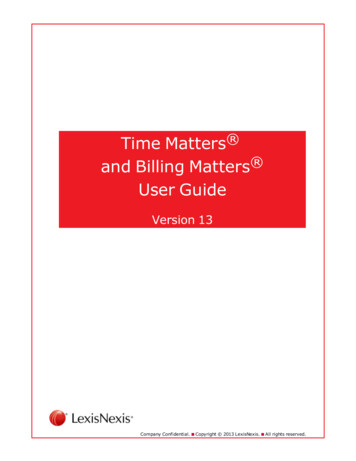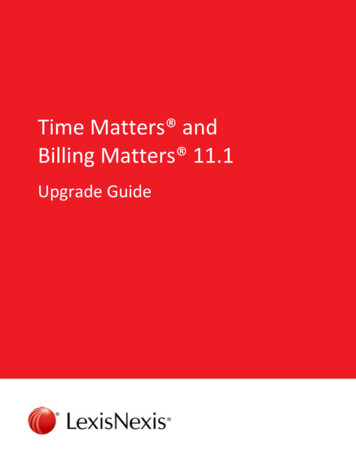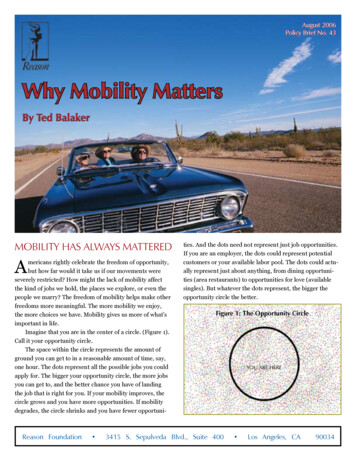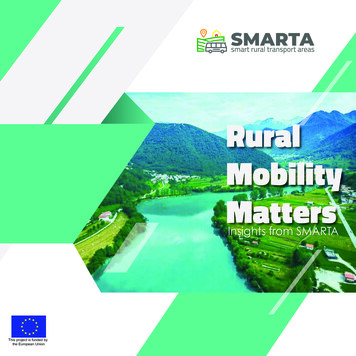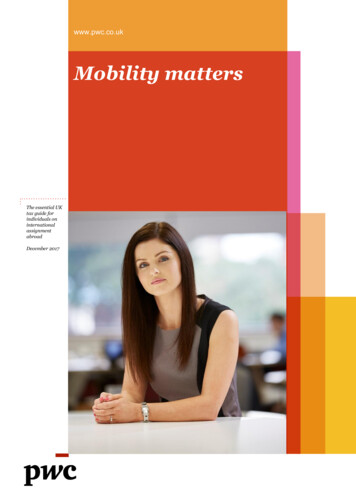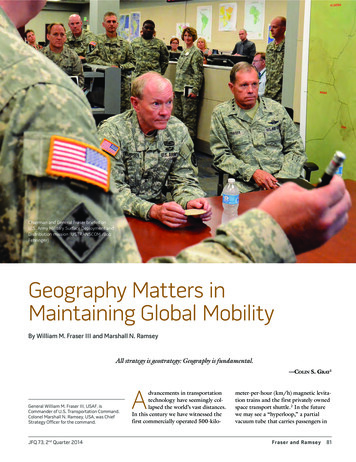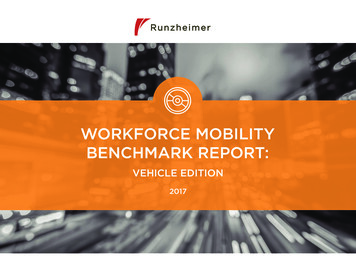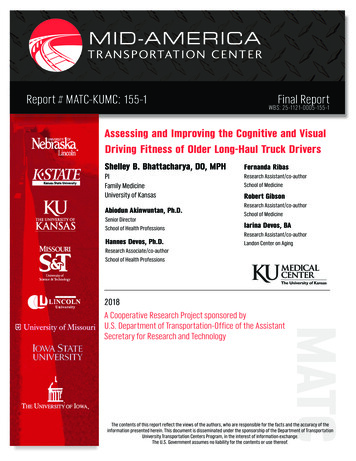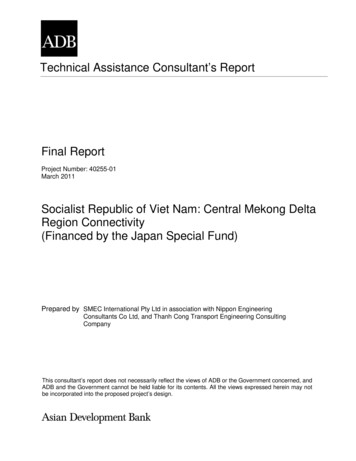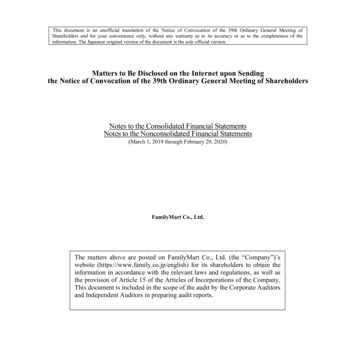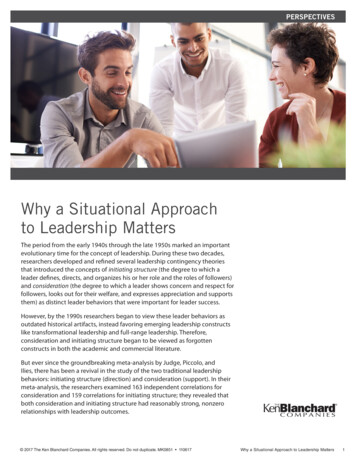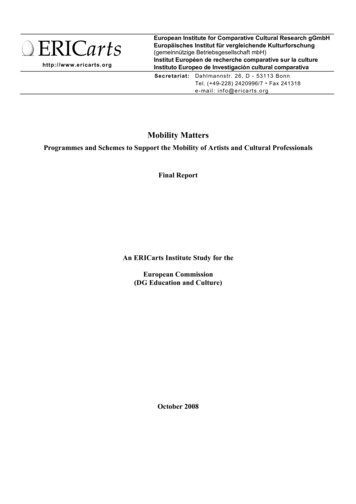
Transcription
ERICartshttp://www .ericarts.orgEuropean Institute for Comparative Cultural Research gGmbHEuropäisches Institut für vergleichende Kulturforschung(gemeinnützige Betriebsgesellschaft mbH)Institut Européen de recherche comparative sur la cultureInstituto Europeo de Investigación cultural comparativaSecretariat:Dahlmannstr. 26, D - 53113 BonnTel. ( 49-228) 2420996/7 * Fax 241318e-mail: info@ericarts.orgMobility MattersProgrammes and Schemes to Support the Mobility of Artists and Cultural ProfessionalsFinal ReportAn ERICarts Institute Study for theEuropean Commission(DG Education and Culture)October 2008
ImpressumThis study was carried out for the European Commission, Directorate-General for Education andCulture. The views taken and analyses presented are those of the authors and do not necessarilyrepresent the views of the Commission or of individual EU Member States. The findings of the studyare based on research carried out in Spring 2008.The Full Report and Annexes are available for download from http://www.mobility-matters.eu ERICarts team (Bonn)Andreas Wiesand (Team Leader)Danielle Cliche (Research Co-ordinator)Oliver Göbel (Project Assistant)Jörg Torkler (Web Design)Charlotte Gemende (Accounting)Key expertsSusanne Capiau (Brussels)Rod Fisher (London)Ilkka Heiskanen (Helsinki)Dorota Ilczuk (Warsaw)Ritva Mitchell (Helsinki)Dimitrije Vujadinovic (Belgrade)National correspondents and other contributors to the projectTsveta Andreeva (Sofia)Anthony Attards (Valetta)Anne-Marie Autissier (Paris)Catherine Boothman (Dublin)Troels Malthe Borch (Copenhagen)Vesna Čopič (Ljubljana)Constantinos Dallas (Athens)Sandrine Devaux (Luxembourg)Elena Di Federico (Turin)Milena Dragićević Šešić (Belgrade)Christopher Gordon (London)Péter Inkei (Budapest)Joris Janssens (Brussels)Zora Jaurova (Bratislava)Janina Krušinskaitė (Vilnius)Ann Larsson (Stockholm)Catherine Lemair (Brussels)Aleksandra Litorowicz (Warsaw)Leena Marsio (Helsinki)Teresa Martinho (Lisbon)Margrit Müller (Bonn)Ece Pazarbasi (Istanbul)Pavla Petrová (Prague)Kornelia Pfeiffer (Vaduz)Jaka Primorac (Zagreb)Veronika Ratzenböck (Vienna)Ferdinand Richard (Marseilles)Bertan Selim (Sarajevo)Judith Staines (Devon)Marilena Stanciu ( Bucharest)Natalija Stošić (Belgrade)Rarita Szakats (Bucharest)Margaret Tali (Tallinn)Zlatko Teodosievski (Skopje)Hubert Theler (Zurich)Baiba Tjarve (Riga)Catarina Toscano (Lisbon & London)Ineke Van Hamersveld (Amsterdam)Lidia Varbanova (Montreal)Anna Villarroya (Barcelona)Christoph Weckerle (Zurich)Participants in the two project workshops (Luxembourg and Düsseldorf) are listed in Annex 7
Executive Summary1.Approach to this studyWith the support of a team of six key experts and national correspondents in 35 countries, theERICarts Institute carried out a six month study for the European Commission between Apriland October 2008 on mobility incentives in the culture/creative sector. This was not intendedto be an audit of all mobility related schemes in Europe, but rather a survey and analysis ofthe range and scope as well as motives and results of such programmes.During the course of the study, ERICarts collected information on mobility trends in differentregions of Europe, on recent debates taking place within individual countries, on existingmobility schemes (their objectives, kind of support, target beneficiaries, eligibility conditionsand the nature of benefits), on the main motives for funding bodies to support mobility and onthe main sources where professionals can find information about mobility incentives orbarriers. The team developed a classification of the main types and objectives of mobilityschemes and tried to assess, on the basis of a rather limited supply of comparable data, theirimpact/effectiveness.The results of the study are presented in a final report with extensive annexes including casestudies. The report is divided into five sections:1.2.3.4.5.Background, methodology and conceptual issues;A diverse mobility environment: trends, drivers, restraints;Mobility schemes for cultural professionals;Assessing the impact and effectiveness of existing mobility schemes; andRecommendations: towards more balanced and productive cultural mobilityprogrammesRecommendations for action are targeted to mobility funders within Member States and callfor complementary action on the part of the European Commission, which respects theprinciple of subsidiarity for EU action in the cultural sector.2.Defining mobilityThe ERICarts study recognises mobility not simply as occasional movements across nationalborders that may be useful to gain professional experience required for career advancement,as well as advance artistic endeavour, but more as an integral part of the regular work life ofartists and other cultural professionals. The study focused on the mobility of the individual,but also examined mobility in the sense of the touring of arts organisations.At the outset, three groups of professionals could be distinguished:First, there are thoseseeking to become mobile and for which mobility schemes can be of particularimportance. Mobility may be their free choice, e.g. to gain new inspirations or engagein artistic endeavour, but could also be a matter of professional survival. In the lattercase, mobility is often tied to the issue of (public) provision of funding andinfrastructure within the country, including incentives for local market developments. A widespread concern of those cultural professionals who are already mobile orwhere mobility is a regular part of their professional practice is how to deal with 'redtape' or how to overcome other impediments to mobility caused mainly by social, taxand, for nationals from third countries, visa regulations.
Finally, there are some who do not really see an urgent need for trans-border mobility(e.g. artists living in 'hot spot' cities or specialist staff of regional arts institutions),particularly if this would mean separation from their families and friends or learning anew language. Providing intelligent motivations to encourage cross-border mobilitymay be the main policy challenge.Reliable and comparable data that would present a clear picture of the size of these differentgroups, of their actual mobility flows and of their potential mobility needs do not exist. Thiscalls for empirical surveys and other research efforts at the EU level.3.Assessing mobility support schemes for cultural professionals in EuropeData on 344 mobility schemes from 35 countries across Europe was collected through aproject questionnaire. These include schemes or funds offered by national, regional or localgovernments, transregional bodies, arms-length or semi-public bodies, cultural institutions,foundations or other private sector actors. The mobility scheme examples served as a basis toidentify a number of meaningful cases in the diverse world of mobility funding for artists andcultural professionals.On the basis of the information gathered, a typology of mobility schemes was developed thatcomprises nine main types of measures. These are: Artists / writers residencies;Event participation grants (e.g. at international festivals);Research grants or scholarships to live and work for a certain time abroad;'Go and see', 'come and see' or short-term exploration grants for individuals;Scholarships for further/postgraduate training courses or similar forms of capacitybuilding;Market development grants (e.g. scouting and other cultural export schemes);Project or production grants, e.g. to support translations or participate in film coproductions;Support for trans-national networking of professionals;Touring incentives for groups, e.g. for music or dance ensembles.A further distinction can be made between outgoing schemes i.e., those which provide supportto the mobility of nationals/residents cultural professionals to travel and work in othercountries and incoming schemes i.e., those designed to attract foreign cultural professionals tovisit/work in their country.In addition to distinguishing various types of schemes, the study identifies seven main objectivesunderpinning mobility programmes and schemes: improving foreign relations; careerenhancement; creativity / new production opportunities; international market development; talentdevelopment; intelligence / information gathering / sharing; and project cooperation / coproduction. Evidence suggests that mobility is not always an explicit objective, but is often animplicit outcome or a means to an end.An assessment of the schemes made against these objectives shows that, in many countries,mobility continues to be an important component of international and regional culturalcooperation agreements, be they multilateral or bilateral. In this context, activities involvingmobility are often seen as tools to promote the image of a country abroad and to exportculture. Traditional bilateral agreements, where they exist, are seen as outdated and out of stepwith the changing, but definitely more international practices of artists and culturalprofessionals. The study suggests that more opportunities are needed for practitioners todevelop their own research and exploration ambitions that are not tied to meeting diplomacyor other political and economic agendas.
The results also indicate that there is a shift taking place towards the introduction of newmobility schemes aimed at promoting creativity and productivity through e.g.production/project co-operation, as well as career enhancement schemes aimed at enablingartists/cultural professionals to participate in major festivals or other events; fewer countriesoffer 'go and see exploration grants' or 'networking grants'. Support for pan Europeannetworks is considered, in many countries, a responsibility of the EU Culture programme.Schemes which introduce artists and cultural professionals to emerging cultural markets inother regions of the world, e.g. Brazil, China or India, have been newly introduced by someMember States.In recent years, the objectives of mobility schemes of governments, arts agencies and foundationshave begun to reflect new political objectives and national priorities such as promoting thecreative industries, cultural diversity or intercultural dialogue; priorities also identified in theEuropean Agenda for Culture (2007). Such schemes are found within, for example, creativeindustry export strategies, international job placement schemes, or capacity building programmes.4.Identifying gaps in provisionWhile the study revealed a diverse landscape of cultural mobility schemes, gaps andimbalances in provision remain.There appears to be a continuing mismatch between resources and demands from a growingnumber of artists and new groups of cultural professionals who want to travel abroad.Although there is evidence that financial resources for mobility have increased in somecountries, the general message emerging from national correspondents and experts involvedin the study is that, with some exceptions, mobility funds are insufficient to cover the fullrange of expenses associated with a mobility experience. It is argued that the levels ofmobility funding set limits on the choice of country an artist or cultural professional can travelto, whether within Europe or to new destinations such as Brazil, India or China.There is a significant imbalance in the number of schemes promoting nationals to engageinternationally compared with the smaller number of schemes supporting inward visits ofcreative people from other countries. This gap in provision perpetuates East-West imbalances(in Europe) and North-South imbalances (globally). The main challenge identified in manycountries is the lack of funds, programmes or infrastructure to receive artists from othercountries. Rectifying the balance of incoming-outgoing schemes could be encouraged in thespirit of commitments made by governments when ratifying the 2005 UNESCO Conventionon the Protection and Promotion of the Diversity of Cultural Expressions.It was to be expected there would be imbalances between different regions of Europe, withCentral and Eastern Europe in particular not offering the range of mobility opportunities to befound in many Northern and Western European countries. This in itself is not surprising, butit does remind us that despite the developing European cultural space, opportunities forcultural professionals to travel, make contacts, build partnerships, conduct research etc., willdepend to a great extent on where they live in Europe.5.Recommendations: towards more balanced and productive cultural mobilityprogrammes5.1Adopt a developmental approach to mobilityThe study recommends maintaining the plurality of actors and funding sources for culturalmobility. It also calls for the adoption of a developmental approach that recognises mobility notsimply as an adhoc activity or as a one-off experience but as a longer term investment in a processleading to specific outcomes (not outputs) over a period of time, e.g.in the course of a career.
Five key building blocks or pillars were identified on which this developmental approachcould be based: intelligence – exploration – resources – fairness - sustainability. In short,artists/cultural professionals need intelligence, not just information, to ascertain whatopportunities are available for them to explore the creative process with their peers in othercountries and make productive contacts; but this is dependent on the availability of financialand human resources and the appropriate capacity to engage in mobility; it is also dependenton fairness in having access to mobility opportunities. Finally, productive engagementinternationally often needs to be sustainable if it is to be effective in the longer term; one-offgrants make it difficult to achieve sustainability or leave a legacy.The following recommendations are built upon these five pillars and are addressed to theEuropean Union and also to governments, regional bodies, NGOs and the researchcommunity in EU member or applicant states.5.2Adopt a cultural diversity dimension to the overall mission and activities ofmobility programmes and grantsBodies and organisations promoting mobility could:a)b)c)5.3recognise social and cultural differences through more targeted measures toempower those who want to engage in mobility activities. Such activities canpromote genuine dialogue;work to ensure that open mindsets that appreciate diverse experiences and culturalexpressions are nurtured through artistic and educational activities. Culture canhelp to stimulate curiosity and instil empathy, as well as provide a basic stock ofknowledge about other cultures and about one's own neighbours; anddevelop joint programmes and projects to increase language capabilities neededfor cross-border cooperation and co-productions especially those spoken in borderregions. This could involve not only educational institutions and related activities,but also activities of the culture/creative sector.Pursue mobility programmes and schemes that support productive mobilityexperiencesMobility funders could:a)b)c)d)e)f)endow residencies and travel grants with adequate funding in order to increase thenumber of 'incoming' artists or cultural operators from different parts of Europeand the world;give priority to foster individual professional advancement, capacity building andexploration through intellectual encounters, artistic innovation and creativeengagement across borders, without an imposed mandate;offer additional support which could help optimise mobility experiences byproviding professionals with the time and resources to engage in dialogue with thelocal community, interact with other artists/cultural professionals, lead workshopsor training opportunities, etc;support direct, productive encounters and project initiatives of cultural professionalsfrom all parts of Europe, including in new member states/candidate countries;target the typical, i.e. small-scale arts institutions/organisations and cultureindustry companies to enable them to participate in international co-productions;encourage sustainability, networking and legacy building in mobility processeswith, for example, follow-up funding, post-production funds, and disseminationaids. Post-mobility workshops for cultural professionals to share their experienceswith peers could also be considered in this context, as much of the valuableexpertise is not always put back into the sector;
g)h)5.4introduce evaluation processes that focus on the outcomes ('impact') rather thanthe outputs of mobility schemes; andprovide additional support to intermediaries as instrumental actors providing'intelligence' (advice, guidance etc) needed to enhance the effectiveness of crossborder mobility.Re-examine cultural diplomacy / international cultural co-operation programmesThe European cultural space is both common and diverse. When cultural professionals aresent abroad by e.g. national cultural institutes to participate in events or programmes, they areoften regarded as ambassadors of a particular country. The public in other parts of the world,however, often see them as Europeans influenced by Europe's cultural diversity. This in mind,governments or cooperation agencies and EU bodies could:a)b)6.increase the number of joint European activities by national cultural institutes andby other cultural diplomacy actors outside of Europe, which could mean anextension of existing forms of collaboration e.g. in the EUNIC network or incooperation with international bodies such as the Asia-Europe Foundation towhich EU states belong. Similar cooperation initiatives could be created in otherworld regions such as Africa and South/Central America; andencourage trans-regional bodies to introduce cultural mobility programmes,where they do not currently exist, and to foster cooperation between the variouslarger regions in Europe.Concerted efforts to address mobility at the European levelThe mobility of cultural professionals figures as a strategic objective of the European Agendafor Culture (2007) and in the EU Work Plan for Culture 2008-2010. The Commission'sincreased engagement with mobility responds to demands from networks and culturaloperators for other financial opportunities to support their work in addition to that which isprovided for trans-national cooperation projects through the Culture Programme 2007-2013.Therefore, the following recommendations are directed to the European Union:a)Initiate action through pilot projects aimed at artists/cultural professionals in2009, with a possible focus on: the creation of a matching fund for mobility to strengthen existing funds andprovide incentives for trans-regional, national, local and independent bodies inorder to implement a developmental approach to mobility funding; improving the transfer of mobility experiences through support for cross-bordertraining modules targeted to different user groups, i.e. funders, intermediaries,professionals seeking to become mobile, in order to ensure a more lastingimpact. The involvement of artists / cultural professionals as 'trainers' is keyand would enable them to share their experiences with others; and the development of online mobility toolkits that provide intelligence, not justmore information, by synthesizing good practice. Such kits could be developedwith the help of agencies, foundations with a European scope, mobilityinformation providers, regional bodies, sector associations and independentexperts.b)Introduce additional activities into the various strands of the current EU Cultureprogramme 2007-2013, as well as in the next generation of the Cultureprogramme:
Multiannual cooperation projects: introduce support for the building of transnational cultural links and project cooperation between cultural operators,networks and institutions whose programme priorities are aimed at promotingthe visibility and mobility of artists/cultural professionals from more diversecultural back
Mobility Matters Programmes and Schemes to Support the Mobility of Artists and Cultural Professionals Final Report An ERICarts Institute Study for the . leading to specific outcomes (not outputs) over a period of time, e.g.in the course of a career. Five key building blocks or pillars were
